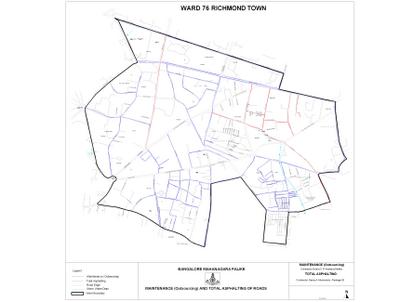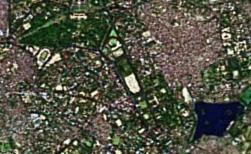Bangalore rots, while I.T. boycotts.
Sir,
The proposed boycott by the I.T. industry is a step in the right direction to emphasise the miserable failure of the elected representatives of the people. It should remind the authorities that Bangalore is like a mango rotting inside while the skin appears mostly perfect. The canker has set in due to the lackadaisical attitude of our ‘elected representatives’. Considering that people employed in the I.T. industry live in Bangalore, I.T. companies are representing them, but the companies should be mature enough not to just look at improving infrastructure from the companies and their employees’ viewpoint but also from the broader viewpoint of all citizens. From what I’ve observed, most companies are satisfied just 'improving' stretches of road or pavement just in front of their offices. They should look beyond this enabling them as well as Bangalore to grow properly.Sunil
Bangalore and Floods
Bangalore and Floods
Hopefully the recent floods in Mumbai have served as a warning to the Bangalore city authorities, where floods can and do occur at the drop of a hat and the fall of a raindrop. A short spell of rain can bring Bangalore to a grinding halt. Prolonged rains can turn Bangalore into a watery grave.
Bangalore saw the formation of its original drainage system under British rule, when stonewalled box drains led storm water to nearby lakes. This was sufficient for those days. With the ‘modernization’ of Bangalore, the drains remained the very same while lakes were drained and the beds encroached upon in Man’s greed and need for more space and more land.
We then reached the phase where traffic in Bangalore started increasing, and the civic authorities in their shortsighted plans to ease traffic congestion decided to increase ‘motorable’ road surface by widening roads and thereby reducing pavement width and removal of pavements on some roads. The unseen victims of these measures were the old storm water drains. As they lay directly below pavements that were being altered, they fell victim to the cost cutting contractors who replaced them with even shallower and narrower drains.
The next step forward for corporators returning from foreign tours was to implement ‘modern paving techniques’. This led to laying interlocking pavers in a bed of sand over existing slabs covering storm water drains. The result can be witnessed on several roads. In some places they have collapsed into the very drains that they were supposed to cover and in other areas they are sinking due to the sand leaking into the narrow and shallow drains below clogging them.
There is also no scientific method followed of contouring (cambering) the road surface so that water doesn’t stagnate on the road surface but flows into drain inlets. On some roads you will be surprised to see the complete absence of drain inlets, though a drain will exist on the shoulder of the road. This indicates the presence/ existence of influential individuals or corporates on that road, who influence the authorities to camber those roads so that rainwater flows into adjoining areas. This NIMBY (Not In My Backyard) syndrome affects entire Bangalore, and no combined scheme can be successfully implemented until the syndrome is cured.
Fat cats from the corporate world flout traffic rules and park their cars illegally on pavements, breaking slabs. The hole is quickly filled up with debris and garbage contributed by passing Bangaloreans, resulting in another blocked drain. Only the traffic police can prevent such happenings by providing railings for pavements and booking offenders.
No proper filter mechanism is implemented at the drains inlets. Desilting of drains when done is at the most, manual opening of drains and the silt thrown onto the roads, waiting for the next rains to wash them back into the very same drains.
Bangalore requires wider, deeper storm water drains fitted with a rain water harvesting mechanism. Creation of new, deeper artificial lakes, and a proper mechanism to channel water there is an expensive proposition and is less likely to be implemented by political parties more concerned with self-survival than the survival of Bangalore.
Until some measures are taken on a war-footing with the future thought of as well, Bangalore remains a disaster waiting to happen.
Sunil
Compound wall collapses..
The compound wall of the Samyuktha Karnataka newspaper press on D'SouzaRoad, opposite Devatha Plaza late at night on Wednesday 20th July, 2005 collapsed on an auto and scooter crushing them. I guess its lucky that no one was hurt or killed.
-Sunil
The Hindu : Restoring to the Garden City its pristine glory
An article of mine published in The Hindu newspaper:
http://www.hinduonnet.com/thehindu/2001/01/28/stories/0428402q.htmOther reading material
The Big DigMr Tunnel-Sunil
Are public roads for public use??

Sir,
I came across the attached map of wardworks in ward 76. From it I found out that behind Devatha Plaza (Residency Road) and in front of the LIC officers quarters off Hayes Road, a road has been marked with a blue line indicating that it comes under the maintenance contract which has been assigned by the BMP to a contractor.
But if your reporters were to visit the area, they would be stunned to realise that a barrier has been setup at both ends of that road, and it is like a private parking area with no throughfare allowed!! Does the BMP now maintain private areas using public money or can any private party cordon off public space and utilise it for private purposes?? So can we block any road we want to and utilise it as a private space?
Yours sincerely,
Sunil Pichamuthu
A dying corporation

A dying corporation
Sir,
The latest attempt to enforce BMTC bus use among school children hints at the realization of the government that with an upcoming Metro Rail and other transportation methods, the BMTC is going to see a downswing in its fortunes.The photo on Page 2(DH, Jul 2nd, 2005) shows that our pavements haven’t been designed for school children let alone others to walk upon. Can the traffic police do something about that? Like increasing pavement area and creating pavements on roads lacking them? Can they ensure that pedestrian crossings are safe? BMTC buses are also to blame for traffic jams! I have seen several traffic policemen mute witnesses to buses blatantly flouting traffic rules, as they take turns from wrong lanes, stop in the middle of roads away from bus stops, jump signal lights. A few months earlier a BMTC bus carrying schoolchildren met with an accident near the GPO[see
DH Report,
The Hindu report]. What will the police do ahead of time to ensure such incidents don’t happen? Can they post 10-15 policemen per school forever?It is time they got back to the drawing board and studied the situation in a broader perspective.
Sunil Pichamuthu
Let us tar the corporators!
Sir,
For several weeks now, tar has been dumped against the compound wall of our house on D' Souza Road by the city corporation. We had painted it recently at great cost, a few days after which the corporation had slunk up early one morning dumped the tar and fled.
When rioters damage public property they are arrested, the same should be done to the corporators of Bangalore City and they should be tarred and feathered as well!
The government has a lot to answer for, as they are responsible for the damage caused so far.
Also extensive damage is being caused to the pavement slabs on D' Souza Road by cars being parked on the pavement. When the traffic policemen can deploy several men around schools to enforce a parking ban, don't they have the sense to deploy sufficient men to enforce the no parking rule supposedly on one side of D'Souza Road. As they are seen to be colluding with those violating the no- parking law, the traffic police should be booked as well!
Yours sincerely,
Sunil Pichamuthu,
Rain Drain: Reasonfor Brain Drain
Rain Drain: Reason for Brain Drain
Sir,
When an Indian can't walk safely on the pavement during the rains can one complain about him/ her leaving for another country?
In Bangalore, as roads are widened at the expense of pavement area, the width of drains lying below pavements (where a pavement or a semblance of it exists) drastically reduces, thereby reducing their capacity.
In some areas, drains are completely sealed off by large corporates who don't want to see culverts near their offices.
Also vested interests pay corporators to retar roads in front of their houses/ offices so that rain water doesn't flow into storm water drains on their road, thus spoiling the road surface camber, and storm water that should have flowed into a drain, flows on the road surface, and into any low-lying area.
What can be done is, to ensure that a rain-water harvesting mechanism is implemented in the storm water drains, thereby recharging the water table as the water flows through the drain.
On another note: - All elections should be held only after the monsoons, and after all the candidates have been forced to walk on foot through the city during the rains. Those who survive electrocution and/ or drowning should be forced to stay in houses in low-lying areas during the monsoons. If they fall sick they should be admitted to the nearest government hospital. All those who survive could be then permitted to stand for elections.
Regards,
Sunil Pichamuthu
Trees pay for free parking
Sir,
BMP now requires new avenues to acquire revenue, after free parking has been introduced.. They probably hope to gain money through auctioning trees cut.
To pay for this avenues of strong trees in Bangalore have to face the civic body's uncivil axe..
Can they instead widen pavements instead of roads?
Near Residency Road where they had started chopping trees.. Lavelle Road doesn't have any pavement.. Hayes Road's pavement is too narrow to support a huge amount of pedestrian activity.. apart from low wires strung above the narow pavement from electric poles threatening to electrocute all those above a certain height( approx 5ft.)
On Richmond Road.. the pavement is in a sorry state, with broken paving slabs and huge gaps above stormwater drains/drainage waiting to participate in population control..
On Hayes Road, cambering has been done so that rain water is diverted onto De Souza Road while the shoulder drain on Hayes Road has been sealed off!!
I hope your newspaper can publicize these discrepancies of the BMP.
Yours sincerely,
Sunil Pichamuthu,



















